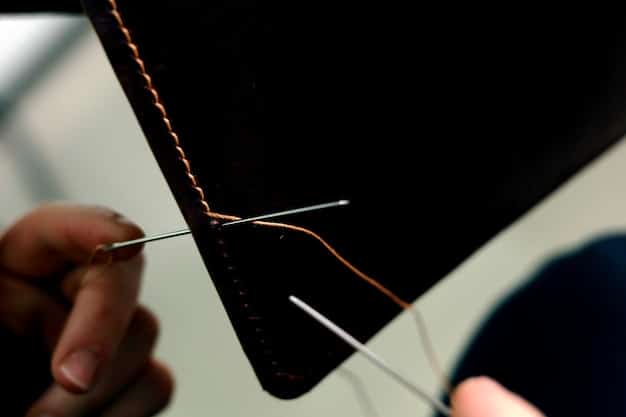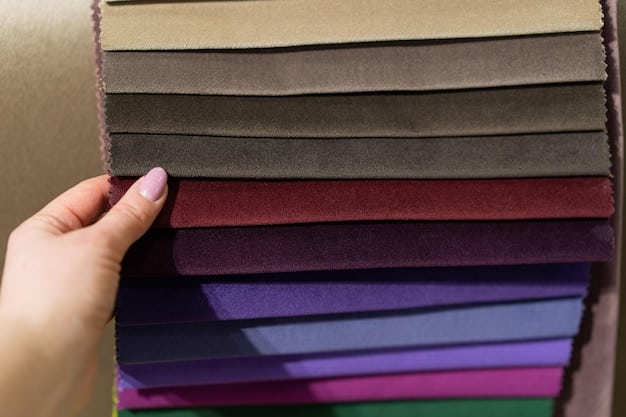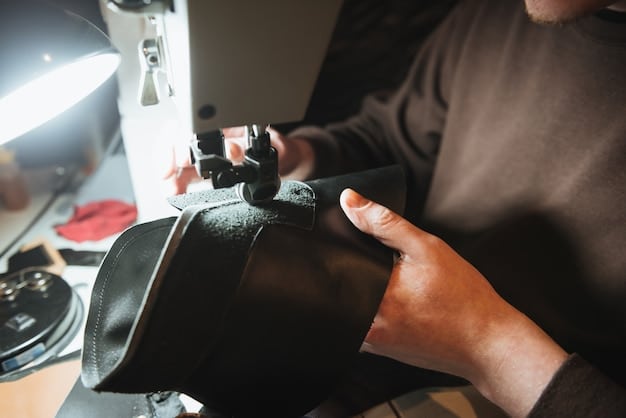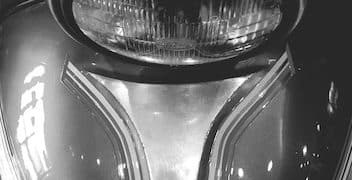The Art of Automotive Upholstery: Comfort and Style in Car Interiors

The art of automotive upholstery involves more than just covering seats; it blends craftsmanship with design to create comfortable, stylish, and personalized car interiors, enhancing the driving experience and vehicle aesthetics.
The allure of a classic car often lies in its meticulously crafted details, and among these, the interior upholstery stands out as a testament to both comfort and style. The art of automotive upholstery: crafting comfort and style in car interiors is a tradition that blends functionality with aesthetics, enhancing the driving experience and preserving automotive heritage.
Understanding Automotive Upholstery
Automotive upholstery is the material that covers the seats, headliners, door panels, and other interior surfaces of a vehicle. It plays a crucial role in the overall comfort and aesthetics of a car, influencing both the driver and passenger experience.
The selection of materials, colors, and textures is a critical part of the design process. Different eras and styles of cars feature unique upholstery designs that reflect the tastes and trends of their time. Understanding the history and techniques involved provides insight into this specialized craft.
Evolution of Upholstery Materials
The materials used in automotive upholstery have evolved significantly over the years, influenced by technological advancements and changing consumer preferences. From the early days of simple fabrics to the modern era of high-tech synthetics and luxurious leathers, each material offers different benefits in terms of durability, comfort, and style.
Key Components of Upholstery
Beyond the surface material, automotive upholstery involves several key components that work together to provide comfort and support. These include padding, stitching, and support structures. Each element plays a crucial role in ensuring the longevity and aesthetic appeal of the interior.
- Padding: Various types of foam and padding provide cushioning and support.
- Stitching: Different stitching techniques create unique patterns and reinforce seams.
- Support Structures: Frames and springs provide the necessary support for the seats.
In summary, understanding automotive upholstery involves appreciating its historical evolution and its multiple components, each serving a unique purpose in the enhancement of the vehicle’s interior.

Essential Tools and Materials
Automotive upholstery requires a specific set of tools and materials to achieve professional-quality results. These essentials range from basic hand tools to specialized equipment designed for cutting, sewing, and installing upholstery.
Having the right tools not only ensures efficiency but also the precision needed to create a flawless finish. Knowing the properties of different materials and their applications is equally important.
Hand Tools for Upholstery
Many tasks in automotive upholstery rely on hand tools for precision and control. These tools include items like seam rippers, hog ring pliers, and upholstery needles.
Sewing Machines and Equipment
A heavy-duty sewing machine is essential for stitching upholstery materials together. Additionally, tools like air compressors and staple guns help with securing fabric to frames.
- Seam Ripper: For removing old stitches.
- Hog Ring Pliers: To secure fabric to frames with hog rings.
- Upholstery Needles: Long, strong needles for hand-sewing thick materials.
Possessing the right tools and understanding their proper usage is critical for accomplishing high-quality automotive upholstery work.
Types of Upholstery Materials
The choice of upholstery material significantly affects the durability, comfort, and appearance of a car’s interior. Each material has its unique advantages and disadvantages, making it suitable for different applications and preferences.
Factors such as cost, maintenance, and environmental impact also play a role in the selection process. Understanding these aspects helps in making an informed decision.
Leather Upholstery
Leather is a popular choice for its luxurious feel and durability. It offers a premium look and can withstand wear and tear with proper care.
Vinyl Upholstery
Vinyl is a synthetic material that is more affordable than leather and resistant to stains and fading, making it easier to maintain.
Fabric Upholstery
Fabric options range from durable weaves to plush velours, providing a wide array of textures and colors. It is generally more breathable than leather or vinyl.
The right material selection can significantly enhance both the aesthetic and functional aspects of a vehicle’s interior. It often involves balancing considerations of cost, comfort, and maintenance efficiency.

The Upholstery Process: A Step-by-Step Guide
The process of automotive upholstery involves several steps, beginning with the removal of the old upholstery and culminating in the installation of the new material. Each step requires attention to detail to ensure a professional-looking finish.
From measuring and cutting fabric to sewing and installing, precision is essential. Proper preparation and technique ensure a long-lasting and aesthetically pleasing result.
Removing Old Upholstery
The initial step involves carefully removing the existing upholstery, taking note of how it is attached and patterned. This provides a template for the new upholstery.
Cutting and Sewing New Upholstery
Using the old upholstery as a template, the new material is cut to size and sewn together. This requires precision to ensure a snug and accurate fit.
Installation and Finishing Touches
The new upholstery is then installed onto the seat frame, using techniques such as hog ringing and stretching. Finishing touches ensure a smooth and professional appearance.
- Template Creation: Use the old upholstery as a guide.
- Sewing: Ensure tight and even stitches.
- Stretching: Pull the fabric taut for a smooth finish.
Careful execution of each step in the upholstery process is essential for achieving a high-quality and durable result.
Customization and Design Options
Automotive upholstery offers many opportunities for customization, allowing vehicle owners to personalize their interiors to reflect their individual style. From unique stitching patterns to custom color combinations, the possibilities are virtually endless.
Customization can enhance both the aesthetic appeal and the overall comfort of a vehicle. It allows for the creation of a truly unique and personalized driving environment.
Stitching and Pattern Designs
Different stitching patterns, such as diamond stitching or quilted designs, can add a distinctive touch to the upholstery. These details can significantly alter the look and feel of the seats.
Color and Material Combinations
Mixing different colors and materials can create a striking and personalized interior. Contrasting piping and inserts are popular ways to add visual interest.
Adding Personal Touches
Embroidered logos, custom headrests, and personalized inserts can further enhance the individuality of the upholstery. These details make the interior truly unique.
Customization in automotive upholstery provides a venue for vehicle owners to express their creativity and personal taste, resulting in interiors that are both comfortable and visually appealing.
Maintenance and Care Tips
Proper maintenance is essential for preserving the appearance and longevity of automotive upholstery. Regular cleaning and care can prevent wear and tear, keeping the interior looking its best for years to come.
Different materials require specific cleaning methods to avoid damage. Understanding these techniques ensures that the upholstery remains in top condition.
Cleaning Leather Upholstery
Leather should be cleaned regularly with a leather cleaner and conditioner to prevent drying and cracking. Avoid harsh chemicals and abrasive materials.
Cleaning Vinyl Upholstery
Vinyl can be cleaned with a mild soap and water solution. Regular cleaning prevents stains and keeps the surface looking fresh.
Cleaning Fabric Upholstery
Fabric upholstery can be vacuumed regularly to remove dirt and debris. Stains should be treated promptly with a fabric cleaner.
- Vacuum Regularly: Remove loose dirt and debris.
- Spot Clean Stains: Address stains immediately to prevent them from setting.
- Use Proper Cleaners: Use cleaners specifically designed for the upholstery material.
Consistent and correct maintenance helps keep automotive upholstery in excellent condition, extending its lifespan and preserving the vehicle’s interior aesthetics.
| Key Point | Brief Description |
|---|---|
| 🛠️ Essential Tools | Includes seam rippers, sewing machines, and hog ring pliers. |
| 🧵 Material Types | Leather, vinyl, and fabric each offer unique benefits and styles. |
| 🎨 Customization | Offers options like unique stitching, colors, and personalized touches. |
| 🧼 Maintenance | Involves regular cleaning and specific care for different materials. |
FAQ
▼
Automotive upholstery refers to the materials covering a vehicle’s seats, headliners, and door panels. It combines aesthetic design with comfort and durability to enhance the driving experience.
▼
Proper maintenance ensures the longevity and appearance of your car’s interior. Regular cleaning prevents wear, stains, and damage, preserving the vehicle’s value and comfort.
▼
Leather, vinyl, and fabric are popular choices. Leather offers luxury and durability, vinyl is cost-effective and easy to clean, and fabric provides comfort and design variety.
▼
Customization options include selecting unique stitching patterns, combining different colors and materials, and adding personal touches like embroidered logos or custom headrests to reflect individual style.
▼
Essential tools include a heavy-duty sewing machine, seam ripper, hog ring pliers, upholstery needles, and staple guns. These tools assist in cutting, sewing, and securing materials properly.
Conclusion
In conclusion, the art of automotive upholstery is a detailed and creative process that combines craftsmanship, design, and a deep understanding of materials. Whether you’re restoring a classic car or customizing a modern vehicle, the right approach to upholstery can drastically enhance both the comfort and aesthetic appeal of the interior, providing a unique and personalized driving experience.





